Table of Contents
The Economic Survey 2024, released on July 22, 2024, a day before the Union Budget, provides an in-depth analysis of India’s economy and future outlook. Delayed due to the general election, it was presented by Chief Economic Adviser V. Anantha Nageswaran. This comprehensive document is crucial for economists, policymakers, scholars, and UPSC aspirants, offering valuable insights into the country’s economic performance and policy recommendations.
Economic Survey 2023-2024
On July 22, 2024, Finance Minister Nirmala Sitharaman presented the Economic Survey 2023-24 in the Lok Sabha. The survey forecasts India’s GDP growth at 6.5%-7% for FY25 and projects a decline in inflation to 4.5% by FY25. It highlights reduced fiscal deficit, improved Current Account Deficit (CAD), and strategic focuses on private investment, MSME expansion, and green transition. These insights set the stage for the upcoming Union Budget 2024-25.
| Economic Survey 2024 Overview | |
| Details | |
| History | First in 1950-51 |
| Presented By | Finance Minister of India |
| Prepared By | Department of Economic Affairs under Chief Economic Advisor V Anantha Nageswaran |
| Total Parts | Two, Part 1 and Part 2 |
| Release Date | 22 July 2024 |
| Constitutional Provision | No |
| Nature of Recommendations | Advisory |
| Importance | Provides insights for policymakers, informs about economic conditions, growth outlook |
| Official Website | https://www.indiabudget.gov.in/economicsurvey/ |
Economic Survey 2023-2024 Highlights
The Economic Survey 2023-24 offers an in-depth analysis of India’s economic performance and future outlook. Here are the key highlights:
| Category | Details |
|---|---|
| GDP Growth Projection | 6.5% – 7% for FY25 |
| Current Inflation | Decreased from 6.7% in FY23 to 5.4% in FY24 |
| Future Inflation | Projected to be 4.5% in FY25 and 4.1% in FY26, assuming normal monsoon and no major shocks |
| Food Inflation | Increased from 6.6% in FY23 to 7.5% in FY24 due to adverse weather impacts |
| Fiscal Deficit | Reduced from 6.4% of GDP in FY23 to 5.6% in FY24 |
| Current Account Deficit (CAD) | Improved to 0.7% of GDP in FY24 from 2.0% in FY23, supported by strong services exports |
| Private Investment | Emphasis on boosting private investment |
| MSME Growth | Strategic priority on expanding Mittelstand (MSMEs) |
| Agricultural Potential | Focus on removing policy impediments to unlock agricultural growth |
| Green Transition | Securing financing for green and sustainable initiatives |
| Education-Employment Gap | Bridging the gap between education and employment |
| State Capacity | Building state capacity to sustain and accelerate economic progress |
| Healthcare | Over 34.7 crore Ayushman Bharat cards issued; 7.37 crore hospital admissions covered |
| Education Initiatives | NEP 2020 aiming to improve foundational literacy and numeracy; ‘Poshan bhi Padhai bhi’ program for preschool education |
| Employment | Unemployment rate decreased to 3.2% as of 2022-23; net payroll additions under EPFO more than doubled |
| Skill Development | Increased number of candidates undergoing skill development through government programs |
Economic Survey 2024 Key Points
The Economic Survey 2023-24, tabled by Finance Minister Nirmala Sitharaman on July 22, 2024, provides a comprehensive analysis of India’s economic performance and projections. This key document sets the stage for the Union Budget 2024-25, offering insights into India’s growth prospects, inflation trends, fiscal health, and strategic priorities for sustainable development.
India’s Growth Outlook for FY25
The Economic Survey projects a robust real GDP growth rate of 6.5% to 7% for FY25. Several domestic and external factors support this optimistic forecast:
- Economic Resilience: India’s economy has demonstrated resilience despite global uncertainties, bolstered by strong domestic demand and a recovering private sector. Structural reforms, such as the Goods and Services Tax (GST) and Insolvency and Bankruptcy Code (IBC), are beginning to yield positive results.
- Agricultural and Rural Performance: A favourable monsoon forecast and improved agricultural conditions are expected to enhance rural demand and economic activity in agrarian regions. This is crucial for sustaining overall economic growth.
Inflation Trends and Projections
Inflation management has been a focal point, with the Economic Survey highlighting the following trends:
- Current Inflation Status: Retail inflation averaged 6.7% in FY23 but has moderated to 5.4% in FY24. This decline is attributed to lower core inflation in both goods and services. Core services inflation has reached a nine-year low, and core goods inflation is at a four-year low.
- Future Projections: The Survey forecasts inflation to further decrease to 4.5% in FY25 and 4.1% in FY26, assuming stable monsoon conditions and no significant external or policy shocks. This is in line with the Reserve Bank of India’s projections and the International Monetary Fund’s (IMF) estimates.
Fiscal Position and External Sector
The Economic Survey presents a positive outlook on India’s fiscal and external balances:
- Fiscal Health: The fiscal deficit has been reduced from 6.4% of GDP in FY23 to 5.6% in FY24. This improvement is attributed to enhanced tax compliance, expenditure control, and increased digitization of financial transactions.
- External Balance: The Current Account Deficit (CAD) has narrowed to 0.7% of GDP in FY24, an improvement from 2.0% in FY23. Strong services exports have counterbalanced the subdued global demand for goods, supporting the external sector.
Medium-Term Growth Strategy
The Economic Survey outlines strategic priorities for sustaining growth over the medium term:
- Private Investment: Boosting private investment is critical for driving economic growth. Policy measures and incentives are necessary to attract and retain private sector investments.
- MSME Growth: Expanding and supporting Micro, Small, and Medium Enterprises (MSMEs) is a strategic priority. The growth of India’s Mittelstand can play a pivotal role in the country’s economic development.
- Agricultural Potential: Recognizing and leveraging the potential of agriculture as a growth engine is essential. Removing policy impediments and investing in agricultural infrastructure will be key to unlocking this sector’s potential.
- Green Transition: Securing financing for India’s green transition is crucial for sustainable development. Policies aimed at promoting renewable energy and reducing carbon emissions will be integral to this transition.
- Education and Employment: Bridging the education-employment gap and improving the quality of education are vital for harnessing the demographic dividend. Focused efforts are needed to align educational outcomes with market needs.
Social and Economic Development
Healthcare: The Ayushman Bharat scheme has significantly improved healthcare access, with over 34.7 crore cards issued and 7.37 crore hospital admissions covered. The scheme has reduced out-of-pocket expenses for impoverished families.
Education: The National Education Policy (NEP) 2020 is transforming the education sector, emphasizing foundational literacy and numeracy. The ‘Poshan bhi Padhai bhi’ program aims to establish a high-quality preschool network across Anganwadi Centres.
Employment and Skill Development: The unemployment rate has decreased to 3.2% as of 2022-23. Net payroll additions under the Employees’ Provident Fund Organisation (EPFO) have doubled over the past five years, reflecting healthy growth in formal employment.
Economic Survey 2024 PDF Download
The Economic Survey 2024, presented by Finance Minister Nirmala Sitharaman, projects India’s GDP growth to be between 6.5-7% for FY25. It highlights stable economic growth, a reduction in inflation from 6.7% to 5.4%, and a robust post-pandemic recovery. The survey also addresses potential risks, including geopolitical conflicts and climate-related challenges. For a detailed analysis and comprehensive insights provided in the Economic Survey, download the Economic Survey 2024 PDF using the link below:
Economic Survey 2024 Highlights Chapter-wise
Chapter 1: State of the Economy
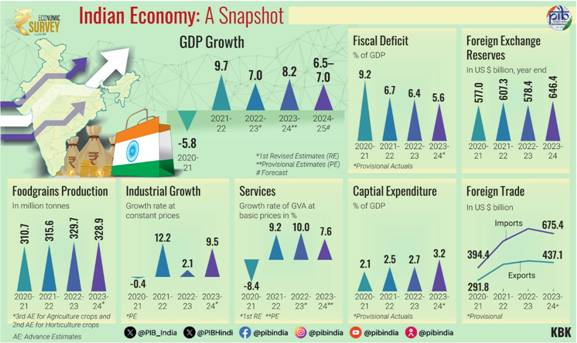
- GDP Growth: India’s economy grew by 8.2% in FY24 despite global challenges.
- Real GDP was 20% higher than pre-pandemic levels.
- Sectoral Growth:
- Agriculture: Grew at a slower pace due to erratic weather.
- Manufacturing: Rebounded strongly, growing 9.9%.
- Services: Continued to drive growth.
- Private Consumption: Remained steady.
- Government Capital Expenditure: Increased significantly.
- Fiscal Consolidation:
- Fiscal deficit reduced to 5.6% of GDP in FY24.
- Tax revenues exceeded estimates due to strong economic activity.
- Capital expenditure increased by 28.2% year-on-year.
- Subsidies declined by 22.1%.
- Inflation: Moderated to 5.4% in FY24 from 6.7% in FY23.
- External Sector: Forex reserves covered 11 months of imports.
Social Indicators
- Unemployment Rate: Declined to 3.2% in 2022-23.
- Female Labor Force Participation: Increased to 37%.
- Poverty Levels: Reduced significantly.
Outlook for FY25
- GDP Growth Projection: Expected real GDP growth of 6.5-7%.
- Risks are evenly balanced.
- Global Uncertainties: Concerns around inflation, geopolitics, and trade persist.
- Domestic Growth Drivers: Expected to remain strong.
Chapter 2: Monetary Management and Financial Intermediation
- Financial and Banking Sector Performance: Demonstrated strong performance in FY24 despite global challenges.
- Bank Credit Growth: Achieved double-digit growth across various sectors.
- Asset Quality: Gross NPAs reached multi-year lows, indicating improved asset quality.
- Capital Adequacy: Banks maintained robust capital adequacy ratios.
- Capital Markets: Strong performance with Nifty 50 up 26.8%.
- Financial Inclusion: Continued progress in financial inclusion and digital payments.
- Insurance and Pension Sectors: Notable growth in both sectors.
- Monetary Policy Stability: Repo rate remained unchanged at 6.5%.
- Liquidity conditions moderated over the year.
- Effective transmission to lending and deposit rates.
- Insolvency and Bankruptcy Code: Emerged as an effective tool for resolving stressed assets.
- Digital Financial Inclusion: Significant strides made through innovations like UPI.
- Retail Participation in Capital Markets: Increased, though caution is needed regarding derivatives trading.
- Insurance Sector Growth: Poised for strong growth but requires improved customer service.
- Pension Sector Expansion: Expanded with scope for further growth.
Chapter 3: Prices and Inflation
- Inflation Management: Retail inflation maintained at 5.4%, the lowest since the pandemic.
- Achieved despite global challenges and weather-related disruptions to food supply.
- Comparative Inflation: India’s inflation was lower than the global and emerging market averages in 2023.
- Core Inflation: Hit a 4-year low in FY24, driven by declining services inflation.
- Food Inflation: Increased due to adverse weather conditions affecting crops like vegetables and pulses.
- Government actions included export restrictions, stock limits, and subsidised retail sales to ensure food security and control prices.
- Interstate Inflation Variations: Notable variations, with more pronounced differences in rural areas.
- Global Commodity Prices: Influenced domestic inflation, especially for edible oils.
Outlook:
- Inflation Projections: RBI and IMF project India’s inflation to align with the target of 4-6% in the coming years.
- Expected decline in global commodity prices is positive for India’s inflation outlook.
Chapter 4: External Sector
- Merchandise and Services Exports: Merchandise exports moderated due to lower demand from major partners.
- Services exports performed well.
- Current Account Deficit: Improved to 0.7% of GDP in FY24 from 2% in FY23.
- Foreign Portfolio Investments: Significant turnaround with net inflows of $44.1 billion in FY24.
- Foreign Exchange Reserves: Increased by $68 billion to $653.7 billion, covering over 10 months of imports.
- Indian Rupee: Remained stable, depreciating only 2.9% against the USD in FY24.
- Global Market Share: India’s share in global goods and services exports is rising.
- Global Value Chain Participation: Increased to 40.3% in 2022 from 35.1% in 2019.
- Free Trade Agreements: New agreements signed with UAE, Australia, and EFTA countries.
- Remittances: Reached $120 billion in 2023, making India the top recipient globally.
- Trade Facilitation: Implemented various measures and reduced logistics costs.
Chapter 5: Medium-Term Outlook – A Growth Vision for New India
- Economic Growth: India’s economy grew from $300 billion in 1993 to $3.6 trillion in 2024.
- The country aims to become a developed nation by 2047, facing challenges like geopolitical tensions, climate change, and shifting global economic dynamics.
Main Areas of Policy Focus:
- Employment Generation: Focus on productive employment in manufacturing and services.
- Skill Development: Addressing the skill gap challenge.
- Agriculture Potential: Tapping the full potential of the agriculture sector.
- MSME Support: Easing compliance requirements and addressing financing bottlenecks for MSMEs.
- Green Transition: Managing India’s transition to a green economy.
- China Relations: Improving relations with China while balancing economic and security concerns.
Six-Pronged Growth Strategy:
- Private Sector Investment: Boosting investment from the private sector.
- MSME Growth: Growing India’s Mittelstand (MSMEs).
- Agricultural Growth: Removing impediments to growth in agriculture.
- Green Financing: Securing financing for the green transition.
- Education-Employment Gap: Bridging the gap between education and employment.
- State Capacity: Building the capacity and capability of states.
Key Initiatives and Policies:
- Production Linked Incentive (PLI) Scheme: Encouraging manufacturing and investment.
- National Infrastructure Pipeline (NIP): Developing infrastructure projects.
- National Monetisation Pipeline (NMP): Monetizing public sector assets.
- Make in India Mittelstand (MIIM) Program: Supporting MSMEs.
- Mission Karmayogi: Civil service reform to enhance governance.
Outlook:
- Growth Projections: IMF projects 6.8% growth for India in 2024-25.
- Economic Ranking: India is expected to become the third-largest economy soon.
- Structural Reforms: Continued focus on structural reforms and a bottom-up approach is needed.
- Sustainable Growth: Emphasis on sustainable, balanced, and inclusive growth.
Chapter 6: Climate Change and Energy Transition
- Carbon Emissions: Despite rapid economic growth, India’s per capita carbon emissions are only 1/3rd of the global average.
- Balancing Development and Sustainability: Aims to achieve “Viksit Bharat” by 2047 and Net Zero by 2070, balancing economic development with environmental sustainability.
- Energy Transition Challenges: Transitioning to cleaner energy while ensuring energy security and affordability.
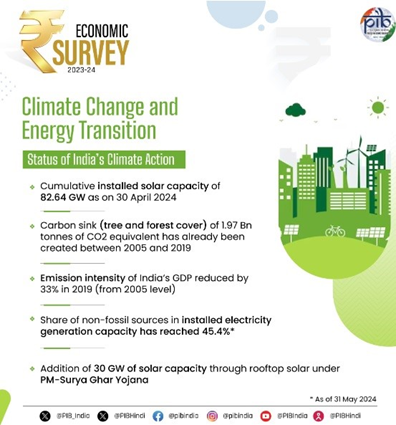
Key Initiatives and Progress
- Climate Action Progress:
- Achieved many targets ahead of schedule.
- Significant increase in renewable energy capacity.
- Solar power capacity grew 25 times between 2014 and 2023.
- National and State-Level Plans: Launched the National Action Plan on Climate Change and state-level action plans.
- Adaptation Measures: Focus on agriculture and coastal regions.
Challenges
- Affordable Finance: Access to affordable finance for the green transition.
- Renewable Energy Issues: Intermittency issues with renewable energy.
- Land and water requirements for renewable projects.
- Critical Minerals: Dependence on geographically concentrated critical minerals.
- Balancing Needs: Balancing energy needs with emission reduction goals.
International Cooperation
- Global Initiatives: Leading initiatives like the International Solar Alliance and Coalition for Disaster Resilient Infrastructure.
- Financial Support Advocacy: Advocating for greater financial support from developed nations for climate action in developing countries.
Policy Focus
- Diversifying Energy Sources: Including renewables, nuclear, and cleaner coal technologies.
- Energy Efficiency: Improving energy efficiency across sectors.
- Carbon Market Development: Developing a carbon market and green credit program.
- Resource Mobilisation: Balancing domestic resource mobilisation with international climate finance.
Chapter 7: Social Sector – Benefits that Empower
- Overall Improvement:
- Multidimensional poverty nearly halved from 0.117 in 2015-16 to 0.066 in 2019-21.
- 5 crore Indians escaped multidimensional poverty between 2015-16 and 2019-21.
- Monthly per capita consumption expenditure increased by 40% in rural and 33.5% in urban areas between 2011-12 and 2022-23.
- Healthcare:
- Government health expenditure increased from 1.4% of GDP in 2014-15 to 1.9% in 2023-24.
- Out-of-pocket expenditure declined from 64.2% to 47.1% of total health expenditure between 2013-14 and 2019-20.
- Ayushman Bharat scheme covered 7.37 crore hospital admissions.
- Education:
- Gross Enrolment Ratio in higher education increased to 4.33 crore in 2021-22 from 3.42 crore in 2014-15.
- Female enrolment in higher education increased by 31.6% since 2014-15.
- Implementation of the National Education Policy 2020 is underway.
- Women’s Empowerment:
- Female labor force participation rate rose to 37% in 2022-23 from 23.3% in 2017-18.
- 6% of Jan Dhan Yojana account holders are women.
- 68% of loans under PM Mudra Yojana sanctioned to women entrepreneurs.
- Rural Development:
- 57 crore toilets constructed under Swachh Bharat Mission-Grameen.
- 7 crore households provided with tap water connections under Jal Jeevan Mission.
- 63 crore houses constructed for the poor under PM-AWAS-Gramin.
- Digital Governance:
- e-Gram SWARAJ platform introduced for digital Panchayats.
- SVAMITVA scheme providing property cards to rural households.
Chapter 8: Employment and Skill Development
- Unemployment Rate: Declined to 3.2% in 2022-23.
- Female Labor Force Participation: Increased to 37% in 2022-23.
- MSME Registrations:69 crore MSMEs registered on the Udyam Registration portal as of July 2024.
- Credit Guarantees:24 lakh guarantees worth ₹2.03 lakh crore approved under CGTMSE in FY24.
- EPFO Payroll Additions: Net payroll additions more than doubled from 61.1 lakh in FY19 to 131.5 lakh in FY24.
- Skill Development: 1,42,67,888 persons trained under PMKVY since its inception in 2015.
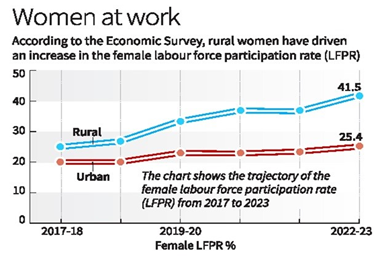
Chapter 9: Agriculture and Food Management
- Growth: Agricultural sector grew at an annual rate of 4.18% over the last five years.
- Food Grain Production: Reached 329.7 million tonnes in 2022-23.
- Financial Support: ₹3.24 lakh crore disbursed to over 11 crore farmers under PM-KISAN.
- Oilseeds Cultivation: Area under oilseeds cultivation increased from 25.60 million hectares in 2014-15 to 30.08 million hectares in 2023-24.
Chapter 10: Industry
- Industrial Growth: Industrial Gross Value Added (GVA) grew by 9.5% in FY24.
- Manufacturing Sector: Achieved an average annual growth of 5.2% over the last decade.
- PLI Schemes: ₹1.28 lakh crore investment reported under Production Linked Incentive (PLI) schemes until May 2024.
- Coal Production: Increased to 997.2 million tonnes in FY24.
Chapter 11: Services
- Economic Contribution: Services sector accounts for 55% of the economy, growing at 7.6% in FY24.
- IT-BPM Sector: Revenue reached $254 billion in FY24.
- Tourism: 92 lakh foreign tourist arrivals in 2023, a 43.5% year-on-year increase.
- E-Commerce Market: Expected to cross $350 billion by 2030.
Chapter 12: Infrastructure
- Capital Expenditure: Increased 2.2 times from FY21 to FY24.
- Metro Rail/RRTS Lines: 945 km operational, 939 km under construction.
- Renewable Energy Capacity: Reached 190.57 GW as of March 2024.
- Optical Fiber Cable: 6,85,501 km laid under BharatNet project.
Chapter 13: Climate Change
- Emission Reduction: India reduced its emission intensity relative to GDP by 33% between 2005 and 2019.
- Non-Fossil Fuel Capacity: Achieved 40% of electric installed capacity through non-fossil fuel sources.
- Per Capita Emissions: India’s per capita emissions remain low at 2.5-2.8 tons CO2eq/year.
- Climate Finance: Developed countries provided only $83.3 billion of the $100 billion climate finance pledged.
The Survey’s Diagnosis

- FDI Environment:
- High interest rates in developed countries have raised funding costs and increased the opportunity cost of investing in developing countries like India.
- India faces competition from industrial policies in developed countries that provide considerable subsidies to encourage domestic investment.
- Geopolitical uncertainties continue to pose challenges.
- China Challenge:
- India remains overly dependent on China for imports, especially for renewable energy components.
- China continues to dominate the low-skills manufacturing space that India aims to occupy.
- AI Threat: The next wave of technological evolution could adversely affect the business process outsourcing (BPO) sector, which has benefited from telecommunications and Internet growth.
- Corporate Sector Response: Despite tax cuts in September 2019 aimed at facilitating capital formation, the corporate sector’s investment response has been lukewarm.
- Between FY20 and FY23, the profit before taxes of the Indian corporate sector nearly quadrupled, but hiring and compensation growth did not keep pace.
- Job Creation Needs: The economy needs to generate an average of nearly 78.5 lakh jobs annually until 2030 in the non-farm sector to accommodate the rising workforce.
- Lack of Timely Data: The absence of good quality and timely employment data hinders proper analysis of the labour market situation.
- Health Risks: Unhealthy lifestyle habits like excessive social media use, screen time, sedentary behaviour, and poor diet are undermining public health and productivity.
Recommended Solutions
- Job Creation by the Private Sector: The private sector, which is currently experiencing high profits, should take the responsibility of job creation seriously.
- Lifestyle Changes by the Private Sector: Indian businesses should embrace and promote traditional Indian lifestyles, foods, and recipes, which have a global market potential.
- Farm Sector as the Saviour:Instead of following traditional economic transition models, India should focus on enhancing value addition in agriculture, boosting farmers’ income, and creating opportunities in food processing and exports.
- This approach can make agriculture more attractive and productive for India’s urban youth.
- Removing Regulatory Bottlenecks: The government needs to further reduce licensing, inspection, and compliance requirements that burden businesses, especially MSMEs.
- Building State Capacity: Instead of big reforms, the focus should be on building state capacity to sustain and accelerate India’s progress.
Conclusion
The Economic Survey 2023-24 underscores India’s economic resilience and growth potential, providing a roadmap for sustainable development. With a focus on enhancing private investment, supporting MSMEs, leveraging agricultural growth, and advancing green transition, India is poised for continued economic progress. The strategic priorities outlined in the Survey will play a crucial role in shaping the country’s economic future and ensuring long-term stability and growth.

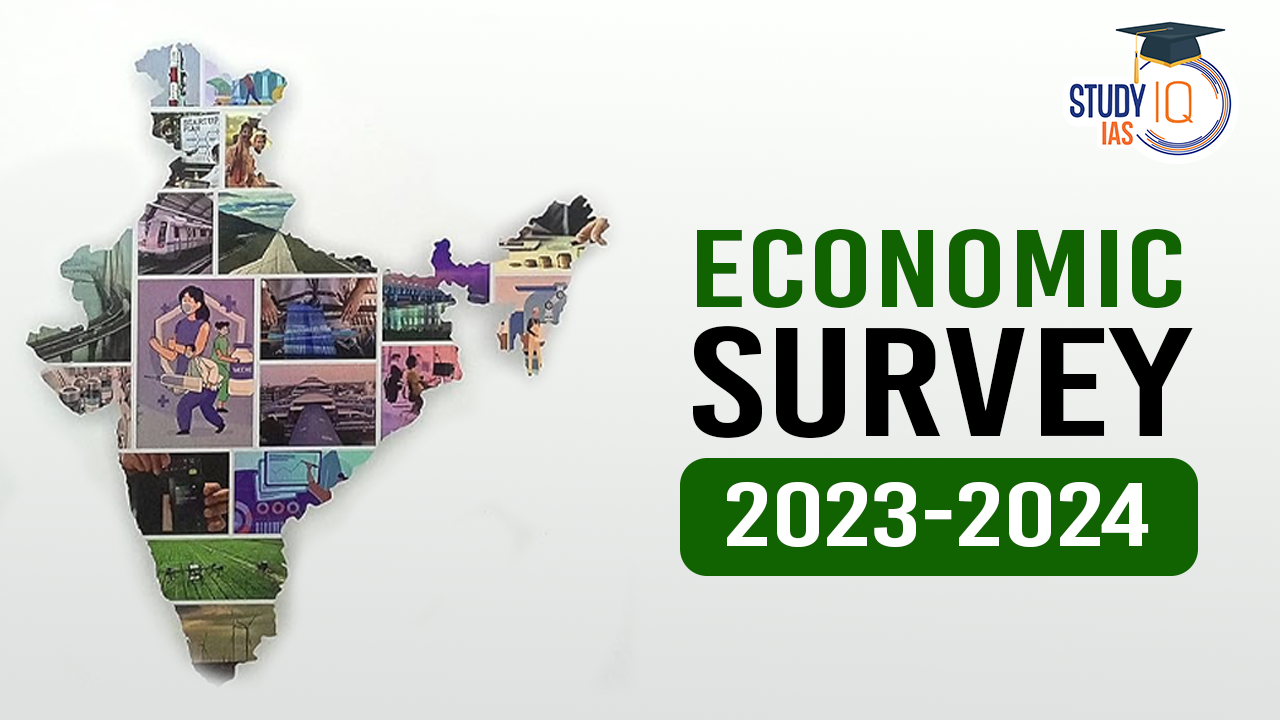
 New Window of Opportunity for India amid...
New Window of Opportunity for India amid...
 Cetacean Morbillivirus: Meaning, Feature...
Cetacean Morbillivirus: Meaning, Feature...
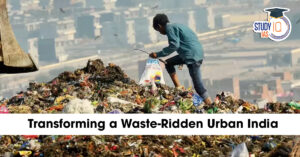 Transforming a Waste-Ridden Urban India:...
Transforming a Waste-Ridden Urban India:...

























